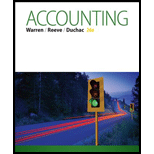
Bundle: Accounting, Loose-Leaf Version, 26th + LMS Integrated for CengageNOW, 2 terms Printed Access Card
26th Edition
ISBN: 9781305715967
Author: Carl Warren, Jim Reeve, Jonathan Duchac
Publisher: Cengage Learning
expand_more
expand_more
format_list_bulleted
Question
Chapter 26, Problem 26.2CP
1.
To determine
Net present value method is the method which is used to compare the initial
To calculate: The net present value of under graduate degree.
2.
To determine
To calculate: The net present value of master of accountancy degree.
3.
To determine
To discuss: The net advantage or disadvantage of pursuing a graduate degree based on the net present value.
Expert Solution & Answer
Want to see the full answer?
Check out a sample textbook solution
Students have asked these similar questions
I am looking for a reliable way to solve this financial accounting problem using accurate principles.
Need answer general accounting question
Last year the return on total assets in Calvin Electronics was 15%. The total assets were 4.5 million at the beginning of the year and 5.5 million at the end of the year. The tax rate was 30%, and sales were $8.2 million. What was the net income for the year?
Chapter 26 Solutions
Bundle: Accounting, Loose-Leaf Version, 26th + LMS Integrated for CengageNOW, 2 terms Printed Access Card
Ch. 26 - What are the principal objections to the use of...Ch. 26 - Discuss the principal limitations of the cash...Ch. 26 - Prob. 3DQCh. 26 - Your boss has suggested that a one-year payback...Ch. 26 - Prob. 5DQCh. 26 - Prob. 6DQCh. 26 - A net present value analysis used to evaluate a...Ch. 26 - Two projects haw an identical net present value of...Ch. 26 - Prob. 9DQCh. 26 - What are the major disadvantages of the use of the...
Ch. 26 - Prob. 11DQCh. 26 - Give an example of a qualitative factor that...Ch. 26 - Prob. 26.1APECh. 26 - Average rate of return Determine the average rate...Ch. 26 - Prob. 26.2APECh. 26 - Cash payback period A project has estimated annual...Ch. 26 - Prob. 26.3APECh. 26 - Net present value A project has estimated annual...Ch. 26 - Internal rate of return A project is estimated to...Ch. 26 - Internal rate of return A project is estimated to...Ch. 26 - Prob. 26.5APECh. 26 - Prob. 26.5BPECh. 26 - Average rate of return The following data are...Ch. 26 - Average rate of returncost savings Midwest...Ch. 26 - Average rate of return-new product Galactic Inc....Ch. 26 - Prob. 26.4EXCh. 26 - Prob. 26.5EXCh. 26 - Cash payback method Lily Products Company is...Ch. 26 - Prob. 26.7EXCh. 26 - Prob. 26.8EXCh. 26 - Prob. 26.9EXCh. 26 - Prob. 26.10EXCh. 26 - Prob. 26.11EXCh. 26 - Prob. 26.12EXCh. 26 - Net present value method and present value index...Ch. 26 - Prob. 26.14EXCh. 26 - Cash payback period, net present value analysis,...Ch. 26 - Internal rate of return method The internal rate...Ch. 26 - Prob. 26.17EXCh. 26 - Internal rate of return methodtwo projects Munch N...Ch. 26 - Prob. 26.19EXCh. 26 - Prob. 26.20EXCh. 26 - Prob. 26.21EXCh. 26 - Prob. 26.22EXCh. 26 - Average rate of return method, net present value...Ch. 26 - Cash payback period, net present value method, and...Ch. 26 - Net present value method, present value index, and...Ch. 26 - Prob. 26.4APRCh. 26 - Alternative capital investments The investment...Ch. 26 - Capital rationing decision for a service company...Ch. 26 - Average rate of return method, net present value...Ch. 26 - Prob. 26.2BPRCh. 26 - Prob. 26.3BPRCh. 26 - Net present value method, internal rate of return...Ch. 26 - Prob. 26.5BPRCh. 26 - Capital rationing decision for a service company...Ch. 26 - Ethics in Action Danielle Hastings was recently...Ch. 26 - Prob. 26.2CPCh. 26 - Global Electronics Inc. invested 1,000,000 to...Ch. 26 - Qualitative issues in investment analysis The...Ch. 26 - Prob. 26.5CP
Knowledge Booster
Similar questions
- Need accounting questionarrow_forwardI am trying to find the accurate solution to this financial accounting problem with appropriate explanations.arrow_forwardTotal production of 3,500 units of finished goods at Tristar Manufacturing required 15,400 actual hours at $18.75 per hour. The standard is 4.2 hours per unit of finished goods, at a standard rate of$19.00 per hour. Which of the following statements is true?arrow_forward
- I am trying to find the accurate solution to this general accounting problem with appropriate explanations.arrow_forwardPlease show me how to solve this financial accounting problem using valid calculation techniques.arrow_forwardWhat is harmony beats record store's contribution margin per unit in dollors.arrow_forward
arrow_back_ios
SEE MORE QUESTIONS
arrow_forward_ios
Recommended textbooks for you
 Managerial AccountingAccountingISBN:9781337912020Author:Carl Warren, Ph.d. Cma William B. TaylerPublisher:South-Western College PubPrinciples of Accounting Volume 2AccountingISBN:9781947172609Author:OpenStaxPublisher:OpenStax College
Managerial AccountingAccountingISBN:9781337912020Author:Carl Warren, Ph.d. Cma William B. TaylerPublisher:South-Western College PubPrinciples of Accounting Volume 2AccountingISBN:9781947172609Author:OpenStaxPublisher:OpenStax College Cornerstones of Cost Management (Cornerstones Ser...AccountingISBN:9781305970663Author:Don R. Hansen, Maryanne M. MowenPublisher:Cengage Learning
Cornerstones of Cost Management (Cornerstones Ser...AccountingISBN:9781305970663Author:Don R. Hansen, Maryanne M. MowenPublisher:Cengage Learning Managerial Accounting: The Cornerstone of Busines...AccountingISBN:9781337115773Author:Maryanne M. Mowen, Don R. Hansen, Dan L. HeitgerPublisher:Cengage Learning
Managerial Accounting: The Cornerstone of Busines...AccountingISBN:9781337115773Author:Maryanne M. Mowen, Don R. Hansen, Dan L. HeitgerPublisher:Cengage Learning EBK CONTEMPORARY FINANCIAL MANAGEMENTFinanceISBN:9781337514835Author:MOYERPublisher:CENGAGE LEARNING - CONSIGNMENT
EBK CONTEMPORARY FINANCIAL MANAGEMENTFinanceISBN:9781337514835Author:MOYERPublisher:CENGAGE LEARNING - CONSIGNMENT

Managerial Accounting
Accounting
ISBN:9781337912020
Author:Carl Warren, Ph.d. Cma William B. Tayler
Publisher:South-Western College Pub

Principles of Accounting Volume 2
Accounting
ISBN:9781947172609
Author:OpenStax
Publisher:OpenStax College

Cornerstones of Cost Management (Cornerstones Ser...
Accounting
ISBN:9781305970663
Author:Don R. Hansen, Maryanne M. Mowen
Publisher:Cengage Learning

Managerial Accounting: The Cornerstone of Busines...
Accounting
ISBN:9781337115773
Author:Maryanne M. Mowen, Don R. Hansen, Dan L. Heitger
Publisher:Cengage Learning

EBK CONTEMPORARY FINANCIAL MANAGEMENT
Finance
ISBN:9781337514835
Author:MOYER
Publisher:CENGAGE LEARNING - CONSIGNMENT